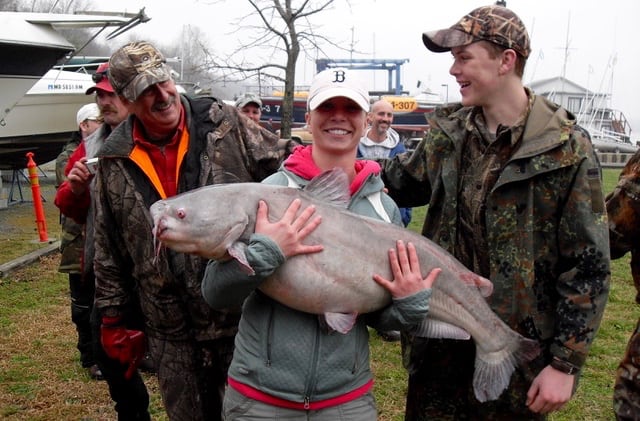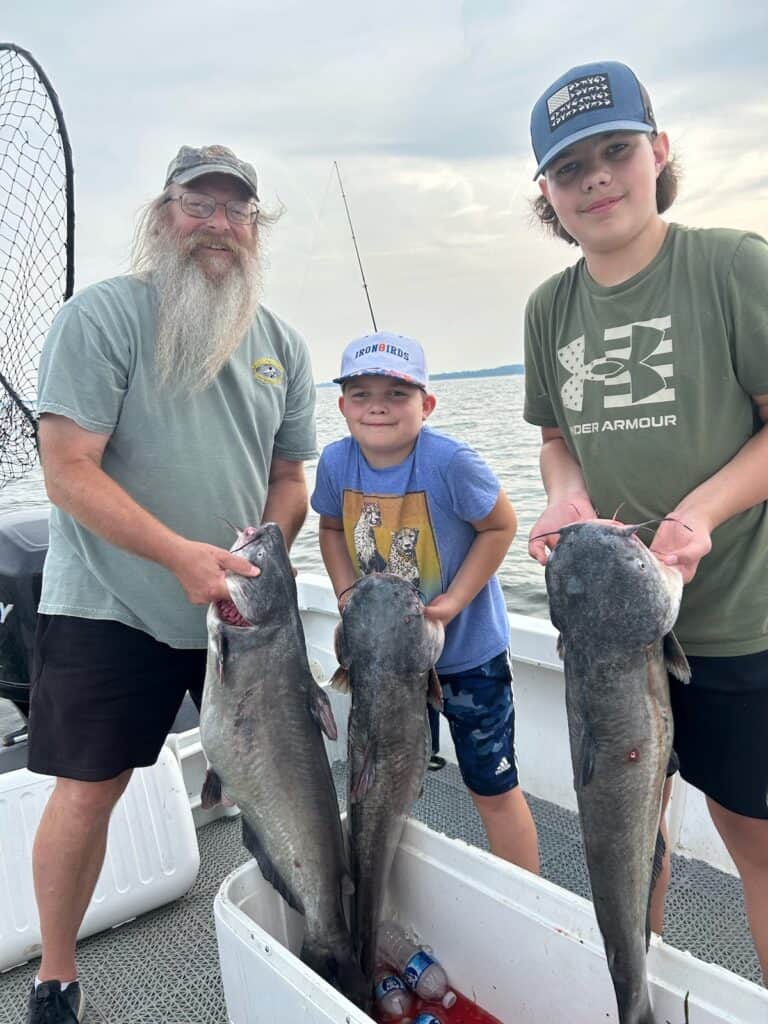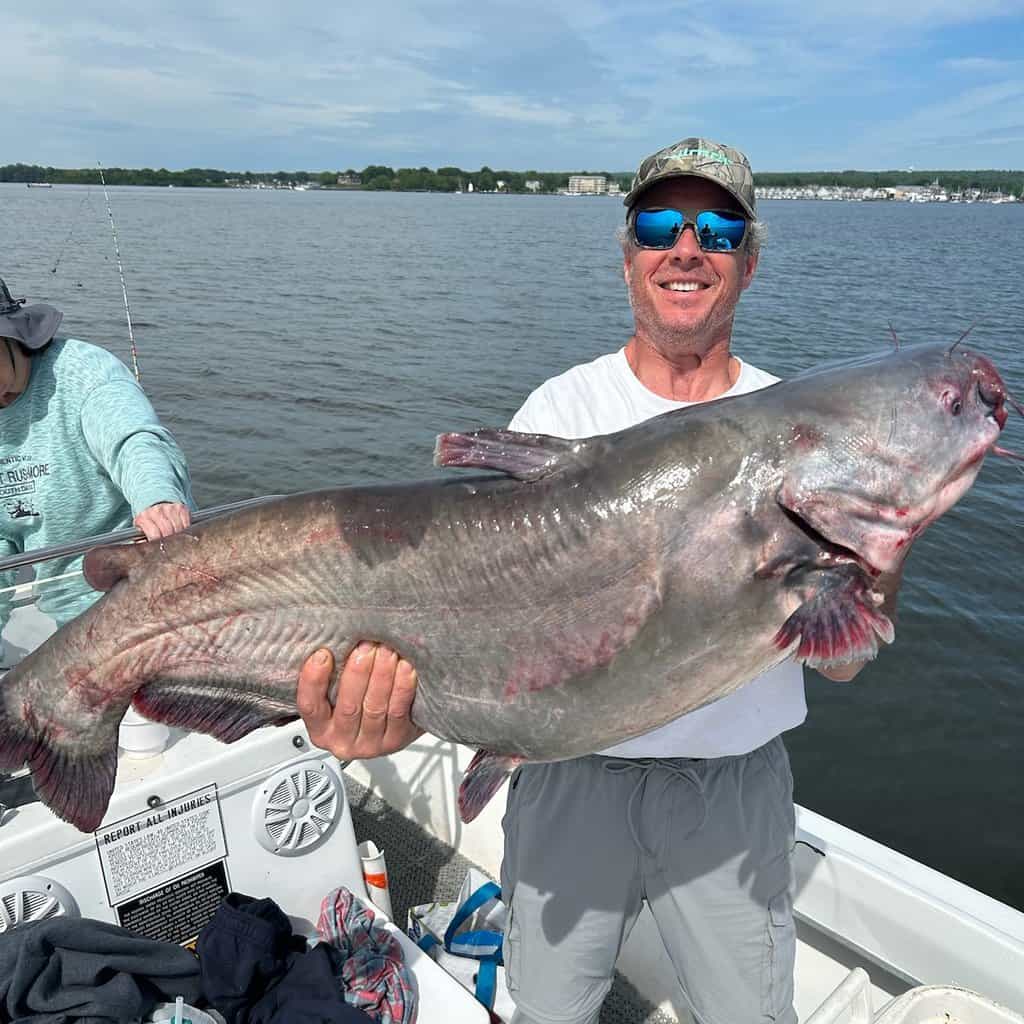This article reveals a dozen rivers and creeks in Maryland where you might land a 50-plus-pound catfish. Maybe even a 100-pounder.
With the arrival of non-native blue and flathead catfish, the rivers that flow through Maryland and into the Chesapeake Bay are now chock full of enormous catfish.
Maryland’s rivers and lakes are also home to popular channel and white catfish fishing (and the largely ignored bullhead catfish). These species don’t get as large as the newcomers, but channel cats, in particular, have been longtime favorites of local anglers.
But the newer arrivals, especially the blues, are the stuff that catfishing dreams are made of. Giant catfish also cause nightmares since they’ll gobble up such beloved species, including blue crabs and native fish. Some people have nicknamed them the “Dumpsters of the Sea.”
Blue catfish have spread throughout most Chesapeake Bay tributaries and can even be caught in the bay itself, especially in upper Chesapeake closer to the Susquehanna River.
The Maryland state record blue catfish weighed 84 pounds, and we won’t be surprised if Maryland joins more than a third of U.S. states that already have produced blues over 100 pounds.
No matter where you catch them, fisheries folks hope you’ll catch and remove as many invasive catfish as you can. (See our note at the bottom of this article about eating catfish.)
To help us share Maryland’s best catfish spots, we talked with Captain Joseph Chamberlain of Bay Raider Outfitters, who has been targeting catfish “since I learned to walk,” as he put it.
This U.S. Marine helped us land on the shores of many of the following great Maryland catfish spots.
Maryland’s Best Catfish Rivers
Potomac River

“The Potomac is the most famous place for the big blue cats,” Captain Chamberlain said, adding that there were blues in almost every tributary of the river.
Some blues caught here are enormous, including the reigning state record.
You can also catch impressive channels and flatheads here.
In the winter and summer months, especially when water temperatures are at their extremes, blues will be in the deepest holes in the Potomac.
During those seasons, look for water between 50 and 80 feet deep, and use weight between 1.5 and 3 ounces to get your offering to the bottom. A fish-finder rig will allow your bait to swim freely in the current while a pyramid sinker gets it to the bottom.
Chamberlain said he starts targeting blue catfish in March, when they’ll often hold at 30 to 40 feet in cooler water.
As the water warms, they’ll move onto flats as shallow as 5 to 8 feet. By June, when water temperatures are around 70 degrees, they begin spawning behavior.
Catfish are notorious for eating any and everything, but for the most success, freshly dead mullet or shad are both popular and productive choices.
While the perception of catfish is that they’ll only eat a motionless meal, we’re reminded of a recent conversation with Jeremiah Caitlin, a U.S. Army chaplain and avid outdoorsman.
Caitlin once caught a big blue catfish that he donated alive to a Maryland Bass Pro Shops for the store fish tank. That big blue went on to eat a pike that was already in the tank. So, these fish will chase down their meal if need be.
Unlike the blue cats, channel cats are widely dispersed in the Potomac, including in the tidal sections and lower river tributaries but also in pools in much of the middle and upper reaches of the river. Find a pool on a summer evening, bait a hook and you should be in business.
Flathead catfish are also more common upriver, especially above Harpers Ferry. Flatheads often respond better to live bait, but it’s not uncommon for them to bite on fresh-cut baits as well.
Access: The Potomac River has excellent boat and bank access. We have numerous suggestions in the linked article.
More: Complete Guide to Potomac River Fishing
Elk River
Little Elk Creek and Big Elk Creek join around the town of Elkton to form the Elk River, which flows into the Chesapeake at the northeast corner of Maryland.
The 9.61-pound Maryland record white catfish was caught right from Turkey Point lighthouse in 2018, and the Elk Neck State Park at that location is a good place to target channel catfish and blue catfish as well.
In the upper bay area especially, blue catfish are commonly caught near the mouths of tributaries and out in the bay.
Hollingsworth Park provides access for anglers on foot on Little Elk Creek and Meadow Park offers the same for Big Elk Creek.
The mouth of the river near Elk Neck State Park will give you your best shots at larger fish, though.
Access: Elk Neck State Park at Rogues Harbor and Elk River Park in Elkton offer public launches.
Susquehanna River

The Susquehanna River is another powerhouse Maryland fishing river with a host of fish species.
Particularly near the Conowingo Dam, you’ve got what’s probably the best place in Maryland to catch giant flathead catfish. The state record of over 50 pounds came from the lower Susquehanna.
Chamberlain says he’s also had good luck with channel catfish near Conowingo Dam.
Chamberlain said he’s even seen channel catfish hitting topwater lures at times, but he will typically get them on cut bait. Chunked eels, in particular, can be very effective.
Farther downriver, where the Susquehanna empties into the Chesapeake, you’ve got good access in Havre De Grace and shots at blue catfish and channel cats as well.
Chamberlain runs his guide service out of Havre De Grace, where his clients catch massive blue catfish off of the flats.
The Susquehanna is also a tremendous bass fishery, widely known as one of the country’s top smallmouth bass fisheries through much of its length. It also can be very good for largemouths in it’s lowest reaches in Maryland.
Access: Some local launches include Millard Tydings Memorial Park in Havre De Grace near the mouth and Lapidum Boat Ramp, a couple of miles above I-95. Conwingo Fisherman’s Park below Conowingo Dam offers excellent bank fishing.
More: Complete Guide to Susquehanna River Fishing
Chester River
The Andover and Cypress Branches come together to form the Chester River near Millington, and Chamberlain said this river can be another catfish hotspot.
The mid to upper reaches have long been known for blue catfish holes, but these days, anglers catch catfish throughout the entire river. The Chester gets wider and deeper as it flows southwest into the Upper Chester River Sanctuary, although the highest concentration of catfish stays in the upper river.
Cut bait is always a good option; chicken liver is another catfish angler’s favorite. Don’t be surprised if catfish hit your jig or other lure.
Access: Deep Landing Road leads to a public ramp about halfway between Chestertown and Millington. Chestertown also has a marina. Lower down, Quaker Neck and Cliffs City also have boating access. For bank access, options include Wilmer Park in Chesterton.
Choptank River
There are so many blue catfish on rivers like the Choptank that anglers are appealing to the state to somehow curb their numbers. Maryland has even asked the federal government for “disaster relief” funding because invasive species like blue catfish are becoming so pervasive.
Keith Lockwood, a fisheries biologist for the state of Maryland, described the Choptank in particular as being “overrun” with blue catfish.
It’s time to do your part.
The deepest holes on the Choptank will be the most likely spots to hold big blue cats, which have been booming for over a decade. You may also catch channel catfish.
The river from Dover Bridge upstream to Denton has the highest number of blue catfish.
Access: Martinak State Park near Denton and Kingston Landing, about two miles above Dover Bridge, have boat launches. Gerry Boyle Park in Cambridge is another option farther downriver.
Patuxent River
It’s not uncommon on the Patuxent to land several blue catfish up to and pushing 20 pounds, even without a boat.
Maryland officials say the highest number of catfish here is from about Jug Bay down to around the Route 231 Bridge at Benedict, a stretch of close to 20 river miles.
If you’d like to narrow that long stretch down, sampling throughout the five river miles below Jug Bay has turned up massive numbers of blue cats.
Access: Patuxent Riverfront Park near Marlboro is right in the thick of the catfish action. Clyde Watson Boating Area is another option downriver.
Nanticoke River
The Nanticoke is another eastern Chesapeake Bay tributary that blue catfish have heavily infiltrated clear up into Delaware.
The river near Sharptown and Vienna is a good bet for blue catfish on the Maryland side. This section is near the mouth of Marshyhope Creek, also a great catfish stream we’ll get to next. Not to mention, the upper Nanticoke River has yielded at least a couple of recent state-record blue catfish in Delaware.
Access: Vienna Waterfront Park off Elliott Island Road in Vienna has a public boat launch. Sharptown also has a public boat launch and a fishing area.
Marshyhope Creek
Marshyhope Creek starts in Delaware and eventually flows into the Nanticoke River, with which it shares a sizeable blue catfish population.
And big ones: We’ve seen photos of a Marshyhope catfish just shy of 80 pounds,
Catfish will be hanging on the steep drop-offs, and as the water gets colder in the fall and winter, expect cats to move deeper.
Look for concentrations of blue catfish in these deep spots. Depending on the current, use between 2 and 4 ounces to hold the bottom and present a fresh chunked bait.
Federalsburg hosts an annual blue catfish tournament, and the stream from there to the mouth at the Nanticoke includes some prime catfishing spots.
Access: Federalsburg Marina and Recreation Park at the intersection of Routes 308 and 318 has a public launch for anglers.
Sassafras River
You have the chance to catch any of Maryland’s more popular catfish species in this northern bay tributary: white, channel, and increasingly blue and flathead catfish.
The flathead cats on the Sassafras (say that three times fast!) can grow to impressive sizes, and this is one of the rivers this invasive catfish has spread throughout.
Between two points known as Little Marsh Point and Rattlesnake Point on the Sassafras, you’ve got your deepest holes, pushing 20-plus feet. A fish-finder rigged with fresh cut bait fished in these holes could be the catfish ticket.
Access: There is a public launch at the end of Shallcross Wharf Road. There also are well-developed marina facilities in Georgetown.
Mattawoman Creek
The 29-pound, 10-ounce state record channel catfish was caught right at the mouth of Mattawoman Creek, and that’s tough to top.
As with most tributaries of the tidal Potomac River, invasive blue catfish have also made themselves at home here.
The nice thing about Mattawoman is that, because it’s a relatively smaller body of water, you can easily fish it from shore or from a canoe or kayak and also chase other species, such as bass and crappie.
The Mattowoman, tide-depending, can have flats that run as shallow as three feet. If you can locate drops down to 10-plus feet adjacent to these flats, they’re good areas to start.
Access: Smallwood State Park is located right on the Mattawoman and has a public launch at the end of Sweden Point Road.
Wicomico Rivers
There are actually two rivers in Maryland called the Wicomico, and both offer good catfish opportunities on opposite sides of the Chesapeake Bay.
Eastern Shore
The Eastern Shore Wicomico is a 24-mile river that begins near the Delaware border and empties into the Chesapeake south of the Ellis Bay Wildlife Management area.
The river system from about Salisbury down offers plenty of blue catfish these days. White and channel catfish also inhabit the river.
Where the Wicomico Creek flows into the river in the northern part of Whitehaven can be a productive spot for bigger blue catfish.
Menhaden, chicken or clams on a fish-finder rig are a favorite tactic here.
Access: The Riverside Boat Ramp off Riverside Drive in Salisbury offers public access.
Western Shore
This Wicomico River is a tributary of the Potomac River, and as such shares the state’s largest blue catfish population.
The Bushwood Wharf Pier in Bushwood is a popular catfish destination, though it can be hit or miss. The Mill Point area, about 4 miles upriver, also holds catfish.
Chicamacomico River
Just south of Rhodesdale, you’ve got the headwaters of the Chicamcomico, which flows down through the Fishing Bay Wildlife Management area, meeting up with the Nanticoke River.
The Chicamacomico is one of the more recent rivers that blue catfish have overrun, although the invasive species are just about everywhere in the tidal Chesapeake rivers now.
Here again, focus on the deepest holes with the slower current in the winter months, and use cut bait with either a pyramid sinker or a fish-finder rig to hold bottom.
Access: The Bestpitch Ferry Boat Ramp is off Bestpitch Ferry Road in Cambridge.
Maryland Catfish Lakes
Maryland’s lakes simply aren’t as productive as its rivers when it comes to catfish, but several can hold channel catfish and other species.
Triadelphia Reservoir anglers report some decent channel cat catches at times.
Rocky Gorge and Liberty reservoirs see the occasional big channel catfish landed, but targeting them in these lakes can be slow going.
Cut bait, chicken livers, nightcrawlers, and other typical catfish baits will do the trick for channels and other catfish where you find them in lakes.
Editor’s Note
The Maryland Department of the Environment recommends limiting consumption of catfish caught in certain state waters. Recommendations can vary and change for different areas and consumers as sampling continues. See their website to check the waters you plan to fish.
Acknowledgment
Big thanks to Captain Joseph Chamberlain of Bay Raider Outfitters for helping us with this article.

